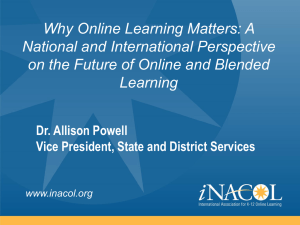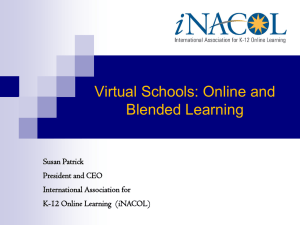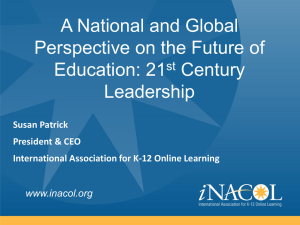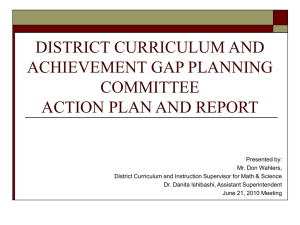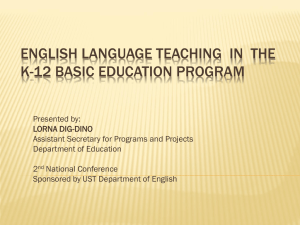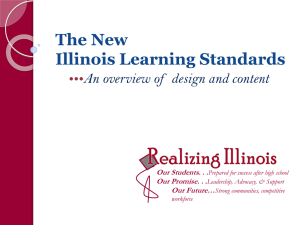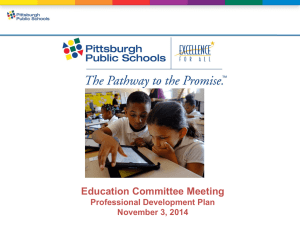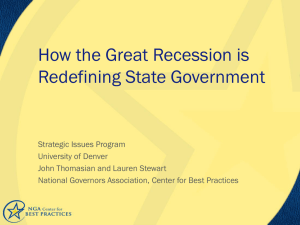Online Learning
advertisement
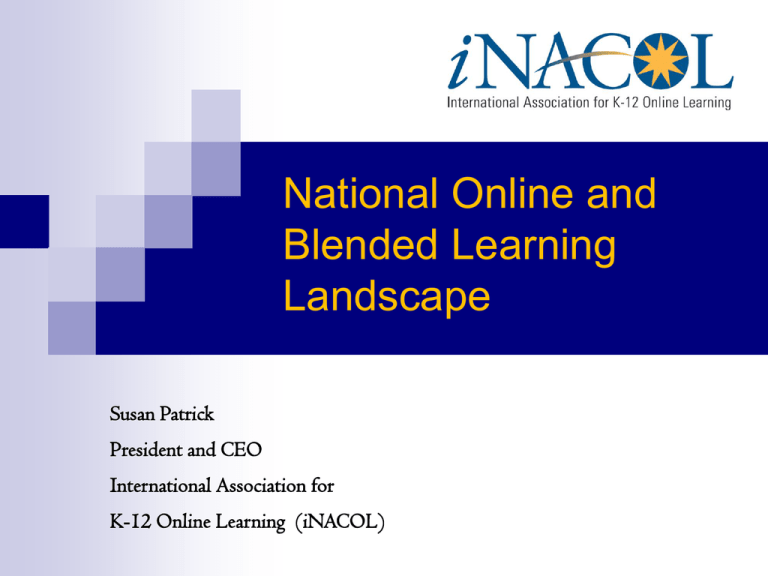
National Online and Blended Learning Landscape Susan Patrick President and CEO International Association for K-12 Online Learning (iNACOL) International Association for K-12 Online Learning (iNACOL) iNACOL is the leading, international, non-profit association in K-12 online learning. Based in the Washington, DC metropolitan area (Vienna, VA) 3000+ members in K-12 districts, states, universities, researchers & online learning providers Provides leadership, advocacy, research, training and networking with experts in K-12 online learning. “Ensure every student has access to the best education available regardless of geography, income or background.” Conference - Virtual School Symposium (VSS) www.inacol.org Do All Students Have Access to the Highest Quality Education? “Advanced Diploma” Courses Additional Course Offerings Advanced Placement, IB or Dual Enrollment/Credit Courses Math & Science Courses Foreign Languages Remediation and Supplemental Resources Excellent teachers/Highly Qualified Teachers Multimedia/Technology Tools to Enhance Instruction National Trends Trends: Higher Education Online Learning Sloan-C “Survey of Online Learning” titled, “Learning on Demand: Online Education in the United States in 2009” studied higher education online enrollments: 1 in 4 college students take an online course 4.6 million online course enrollments in higher education 73% of institutions had increased demand for existing online courses Use of online education was strong for H1N1 contingency plans Growth from economy and H1N1 flu outbreak 20% of schools not offering online classes were introducing online courses as part of H1N1 (academic continuity) contingency plans 74% of public higher education institutions view online education as critical for long-term strategy Trends: Career & Workforce 30-50% of all workforce training and development uses elearning K-12 Online Learning: National Overview The K-12 online learning market is growing rapidly at 30% annually In K-12: 35 states with statewide virtual schools (Keeping Pace) 25 states allow students to enroll in full-time virtual school programs/cyber charters (Center for Education Reform) Michigan, Florida, Alabama, Kentucky, Montana, Idaho K-12 Online Learning is Growing 75 % of school districts had one or more students in a fully-online or blended course K-12 Online Learning enrollments growing 30% annually nationwide 2000: 50,000 enrollments in K-12 online courses 2003: 328,000 enrollments in K-12 online courses 2005: 500,000 enrollments in K-12 online courses 2007: 700,000 enrollments in K-12 online courses 2008: 1,030,000 enrollments in K-12 online courses New Solutions through Online Learning 40% of US high schools do not offer AP courses Teacher Shortages 75% of districts use online learning to offer Advanced Placement or college-level courses. 40% of public school districts in America today say they need online learning resources because certified teachers are not available for traditional face-to-face instruction. 60% of schools and districts say they need online learning for credit recovery. More than 50% need online learning to reduce student scheduling conflicts to graduate on time. Dr. Howard Carlson, Superintendent of Wickenburg USD (AZ) Letter to the Editor: Online learning is growing at an exponential rate . . .today’s students demand greater flexibility, engagement and choice as learners Overcome geographic barriers to learning through technology-oriented education Credit recovery Districts offering full-time and part-time online learning as potential areas of expansion Wickenburg USD identified “online education” as a strategy for each part of implementing the district’s strategic portfolio grades 3-5, 6-8, 9-12 improving access to college-level learning and dualenrollment for high school students Solution learning for district and entire community for life-long Virtual Schools & K-12 Online Learning Diverse Student Needs - meets the needs of diverse groups of students (urban, suburban, rural): Gifted students College-readiness Increase access to AP, IB, dual-enrollment to improve “college-ready” courses and curricula Students with physical disabilities or prolonged absences from school because of illness Help at-risk students summer school redesign, retake online courses, online credit recovery to meet academic requirements Teachers Increase access to highly qualified teachers distribution of best quality teachers through online teaching Providing new professional opportunities to teach online and blended instruction Colorado Colorado Online Learning Small state virtual school Supplemental online courses delivered Limited funding . . . “single largest factor limiting size of individual programs that are not growing is funding.” 1,777 student enrollments Full-time online learning virtual charter schools – several 11,641 students enrolled CDE Reporting: improved w/audit State Virtual Schools: Size and Growth 08-09 Online Learning Research #1 Online Learning Expands Options “The first impetus to the growth of K-12 distance education was an interest in expanding educational options and providing equal opportunities for all learners.” (NCREL 2005) #2 Online Learning Is Rapidly Growing “Recent Surveys show that K-12 online learning is a rapidly growing phenomenon.” Growing 30% annually #3 Is Effective: “Better” U.S. Department of Education Report of Online Learning Better than Face-to-Face (USED 2009) Online Learning Research Highlights U.S. Department of Education study of Online Learning, “Evaluation of Evidence-based Practice in Online Learning: A Meta-Analysis and Review of Online Learning Studies” (2009) “Overall, the meta-analysis found that students who took all or part of their class online performed better, on average, than those taking the same course through traditional face-to-face instruction.” “instruction combining online learning with face-to-face elements had a larger advantage . . .students the participated in online learning and who spent more time on task benefited the most.” Project Tomorrow Survey (2009) Benefits of taking a class online? According to students: 51% said it allows them to work at their own pace 49% to earn college credit 44% said it allows them to take a class not offered on campus 35% said it was to get extra help 19% said they took online courses to get more attention from teachers Trends in K-12 Education: Next Generation Models of Online and Blended Learning •Buffet: F2F & Online Courses •Emporium: F2F place with blended/hybrid approaches to learning Hybrid/ Blended Programs Blended Courses •Online course and/or •Online content •Online instruction •LMS/Technology Online and Blended Course Definitions Allen & Seaman, 2007 Blended Learning: The Convergence of Online and Face-to-Face…the “Best of Both Worlds” • “Blended learning should be approached as not only a temporal construct, but rather as a fundamental redesign of the instructional model with the following characteristics: • -A shift from lecture- to student-centered instruction where students become interactive learners (this shift should apply to entire course, including face-to-face sessions); • -Increases in interaction between student-instructor, student-student, student-content, and student-outside resources; and • -Integrated formative and summative assessment mechanisms for student and instructor.” - Educause, Blended Learning (2004) Blended/Hybrid Learning “Combining face-to-face with fully online components optimizes both environments in ways impossible in other formats” Educause Research Bulletin, 2004 Digital content/curriculum, LMS, online assessments, data system, AI, simulations Shift in instructional model and PD/training Struggling student, low-engagement, (More direct student support needed) Self-direction, high engagement, (Less direct student support needed) Blended Learning: The Convergence of Online and Face-to-Face There is no single type of blended education; student-centered learning Policies: competency-based, multiple pathways New methods: content, assessment, collaborative development, PD, instruction/pedagogy New Platforms: Web-based platform; LMS New Solutions: Continuity of Learning H1N1 Table 1: Key enablers for effective E-Learning Infrastructure and Support Enabler Support for dynamic content and resource management Collaborative tools for groupware management Intelligent indexing/match-making for resources and contents Standards for security and trust On-Demand Quality of Service Knowledge Management Seamless sharing of large pool of resources (information, storage, customized software/hardware and computational power) Support for a dynamic and continuously evolving set of participants Capability Rating (Low, Average, High) Content management system Online communities of learners; Webconferencing; discussion boards; 2L/Virtual Worlds; asynchronous/synchronous tools Playlists; tools for intervention; recommendation engines; adaptive assessments Not open to general public Technical ability to handle varying internet loads Integration with powerful SIS and relational database tools Software/CBT; customized tools; All constituents can access critical information Registration system; mobility; rolling enrollment? Abbas, Umer, Odeh, McClatchey, Ali, Ahmed (authors) of paper, A Semantic Grid-based E-Learning Framework (SELF); Pakistan/U.K. Retrieved March 17, 2010 online: http://arxiv.org/ftp/cs/papers/0502/0502051.pdf. World Future Society Top 10 Breakthroughs Transforming Life over the next 20-30 years Best forecast data ever assembled 1. 2. 3. 4. 5. 6. 7. 8. 9. 10. Alternative energy Desalination of water Precision farming Biometrics Quantum computers Entertainment on demand Global access Virtual education Nanotechnology Smart Robots 1952 Students: Born in 1991 1. 2. 3. 4. 5. 6. 7. 8. 9. 10. The Green Giant has always been Shrek, not the big guy picking vegetables. They have never used a card catalog to find a book. The European Union has always existed. Text has always been hyper. There has always been a computer in the Oval Office. Cable television systems have always offered telephone service and vice versa. There have always been flat screen televisions. They have always been able to read books on an electronic screen. Everyone has always known what the evening news was before the Evening News came on. Migration of once independent media like radio, TV, videos and compact discs to the computer has never amazed them. -From the Beloit College “Mindset List 2013” Today’s Students Born into age of the Internet Information has been universally available and free to them Community is a digital place of common interest, not just a shared physical space. Define characteristics by online actions rather than birth dates or traditional demographic data Millennial Mindspace: Iconoculture’s Nancy Robinson • • • • • • • Global outlook at a younger age Mobile multi-media, more interactive and communitybuilding, socially networked environments to live, play and learn TiVo: time-shifting, on-demand, customization “TV is boring, you can’t customize it.” Demand an unprecedented amount of control of media and they “are not going to give it up” “It’s not about being anaesthetized, it is about being engaged.” Internet as a creator of community Millennial Values: Implications for Education • Today’s students value: • • • • • • • Customization and personalization Ability to scrutinize and provide feedback for improvement Integrity and openness Want collaboration and “serious play” in their education (project-based, real-life experiences in learning) Ability to move fast, at their own pacing Freedom and choice Constant innovation Values Expectations • Millennials want: • Customization and interactivity when learning in a community where open, inclusive and diverse thinking is encouraged • Project-based, team-oriented learning • Clear guidelines, rules and goals • Responsiveness and fast feedback • Involvement in community and volunteer opportunities • “Stand up talking is deadly for this group” Recommendations from Generational Learning Styles 1. 2. 3. 4. 5. 6. 7. 8. Develop online learning communities, online discussion boards, social networking for discussion and analysis. Develop opportunities for experiential learning, field experiences, simulations and case method approaches. Provide lots of structure. Provide lots of feedback. Use technology, blended classes and online learning. Allow for creativity. Recognize the need for social interaction and ultracommunication. Allow focus time, reflection time and discussion time; Give these multi-taskers structure through course design/instructional design. - Julia Coates National Survey for Student Engagement (NSSE 2008) • • • • Online learners reported deeper approaches to learning than classroom-based learners. “Those who teach classes online may be making special efforts to engage their students.” - Alexander McCormick, NSSE Director “People who teach online classes don’t take engagement for granted.” Higher order thinking skills, integrative thinking, reflective learning “The age of true personalization is now upon us.” Questions? Susan Patrick, CEO, iNACOL Spatrick@inacol.org Resources K-12 Online Learning Reports NACOL National Primer on K-12 Online Learning John Watson, Evergreen Consulting - Keeping Pace with K-12 Online Learning Augenblick, Palaich & Associates - Costs and Funding of Virtual Schools iNACOL Promising Practices Series iNACOL Research Reports: 21st Century Skills and Virtual Schools NACOL Needs Assessments Professional Development Access and Equity in K-12 Online Learning Professional Development for Virtual Schools Identifying Needs of States for Online Courses and Services Blended Learning Credit Recovery Socialization conference: Virtual School Symposium (Phoenix, November 2010) Monthly Webinars National Quality Standards for K-12 Online Learning iNACOL National Standards of Quality for Online Courses iNACOL National Quality Standards for Online Teaching
